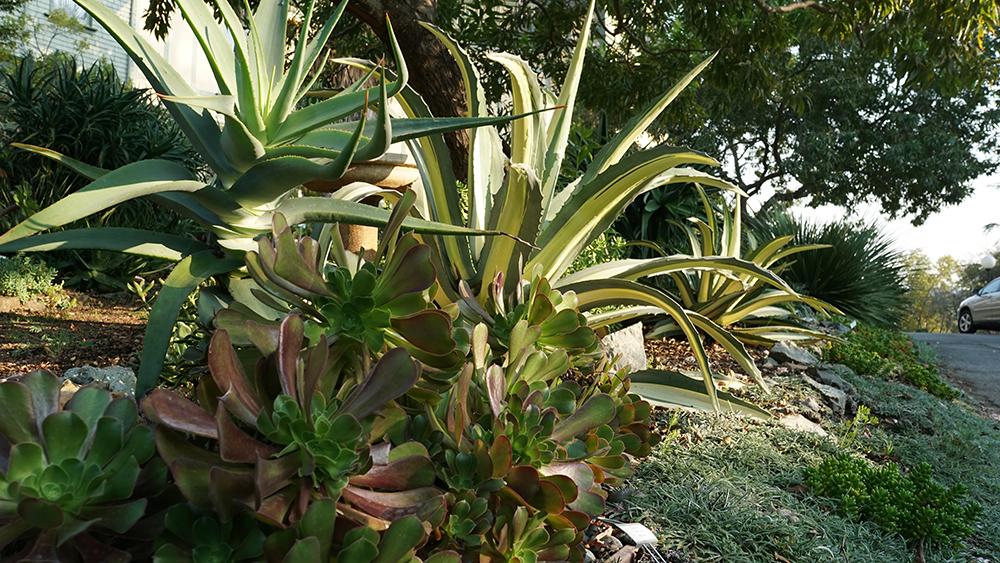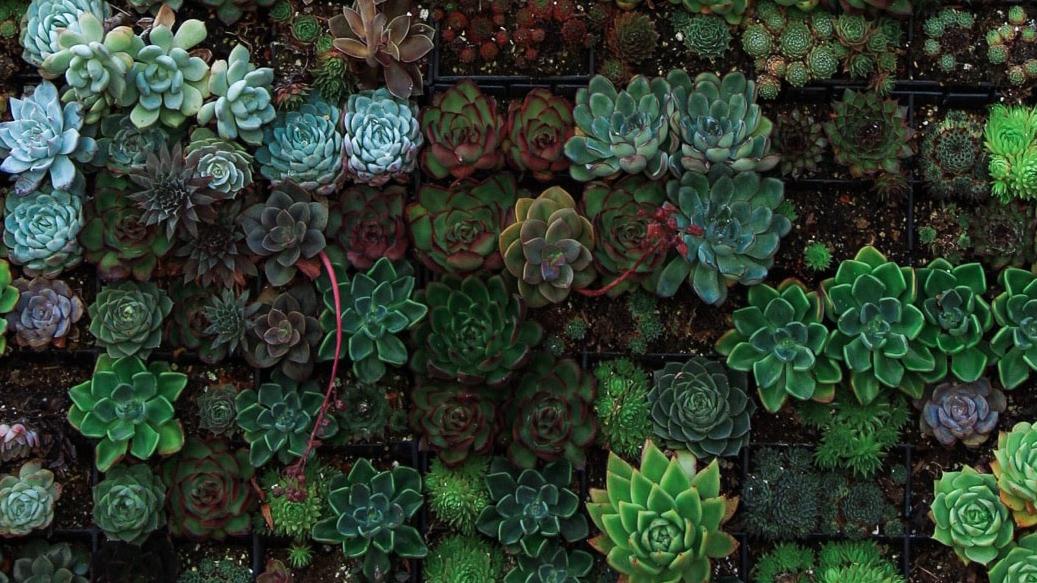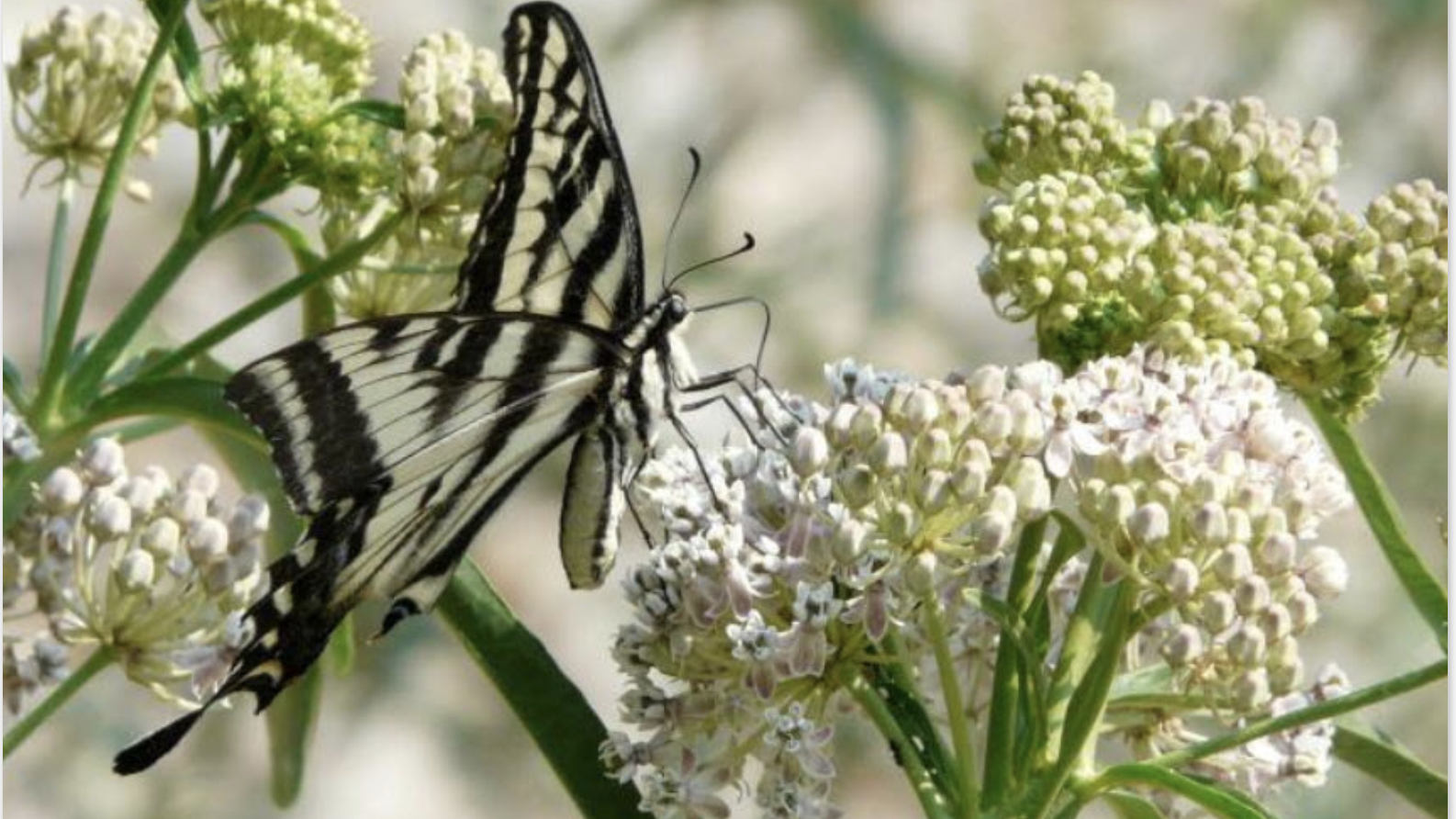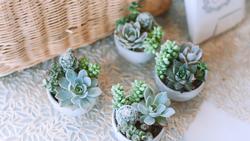Succulents & Other Extra Low-Water Plants

Every summer is dry in Marin and drought is an undeniable reality. In response, many gardeners make it a goal to conserve water wherever possible. One way of achieving that goal is to grow plants that need little or no water. The selection of succulents and other extra-low water plants has exploded in recent years. Thankfully, these plants come in a wide range of shapes, sizes, and colors and are extremely easy to grow.
USE OUR LIST OF > SUCCULENTS
USE OUR LIST OF > IRRIGATION-FREE PLANTS ONCE ESTABLISHED
> About succulents
> About plants that don't need water after they're established
The Multi-Colored, Textured World of Succulents

Succulents are low-water plants that ask very little of the gardener. Some contribute colorful flowers, while others add striking foliage or sculptural forms. They may be planted in decorative pots, borders, or in the hard-to-water corners of the garden. Succulents come from the arid regions of South Africa, Central and South America, and right here in California.
USE OUR LIST OF > SUCCULENTS
These species are popular for a reason: they thrive on little care, they provide profound color and interest to the garden, and they use very little water. Succulents are also easily propagated. A stalk, or even a leaf of a plant, may root itself and grow into a new plant. These are the “pups” – small root-bearing leaf clusters that will grow into a new plant after you pot it.
What succulents need
• Good drainage
• Deep but intermittent watering (allow soil to dry out between waterings)
• Bright light/full sun, depending on species
• Good air circulation
• Well-draining soil that’s relatively low in organic matter. Cold, waterlogged soil presents a challenge for succulents. For this reason, it’s often helpful to plant succulents on a slope or on top of mounded soil.
• Many succulents are frost-sensitive
Succulents are made for water conservation
• Require little or infrequent water because they store large quantities of water and food in the spongy tissue in their leaves, stems, or roots, which they release when needed.
• Those that store water in their leaves often have thick, fleshy leaves covered with a tough skin, such as aloe vera and jade.
• Plants that store water in their trunk often have small branches and leaves.
• Cacti are examples of stem succulents - their leaves have been reduced to spines.
• Epiphytes, plants that are unattached to the ground, are succulents that depend on their ability to store water obtained from rain and fog.
• Some succulents are highly tolerant of salt and other chemicals and can live along the seacoast, in dry lakes or in highly polluted soil.
Water-conserving features shared by succulents
• Leaves that are cylindrical or spherical, reduced in size, or absent
• Fewer stomata (the openings in the leaves that allow transpiration)
• Form of growth that is compact, columnar or spherical
• Shallow roots to absorb moisture from light rain or heavy dew
• Waxy, hairy or spiny outer surfaces that create humid micro-habitats, reducing air movement and water loss
Plants that Don't Need Water After They're Established

Newly planted plants need water to help get their roots well established. After that, most plants need supplemental irrigation to stay alive. But some plants are perfectly happy to live on whatever rain falls in autumn and winter. Many are native or adapted to our summer-dry climate. Of course, in times of drought or prolonged stretches without water, it may be necessary to give plants a little supplemental water just to be sure.
USE OUR LIST OF > IRRIGATION-FREE PLANTS ONCE ESTABLISHED
These plants are valuable contributors to an Earth-friendly garden.
Don't cut off the water all at once! Be sure they are truly mature before reducing water a little bit at a time.
WATCH OUR VIDEO ON HOW TO POT SUCCULENTS!
AND HOW TO PLANT SUCCULENTS SUCCESSFULLY IN YOUR GARDEN
Create and Care for a Succulent Bowl in 10 Steps

STEPS:
• Gather a collection of succulents of varying shapes, textures, and colors.
• If using fresh cuttings, let the stems air dry for a few days to harden over before planting.
• Make sure whatever container you’ve chosen lets excess water drain out. (Drill a small hole at the bottom if it doesn’t.)
• Fill container with a mixture of half potting soil and half lava rock.
• Plant succulents of different shapes, sizes, textures and colors.
• Use small stones or gravel as a mulch on the bare soil.
• Place the container in sun or, preferably, where there’s a little afternoon shade. (If your container is indoors, be sure it gets plenty of indirect light, preferably near a window.)
• Water when the soil is almost dry. Stick your finger in the dirt to test. Water until the excess drains out. In summer, you may end up watering weekly. Don’t worry if you occasionally forget; your succulents will forgive you.
• In winter, move containers inside if possible, or place under eves or other protected area. Many succulents don’t like freezing weather.
• When the “pups” start popping out — that is, new baby succulents — share them with friends.
• Get another container and do it again. It only takes one time to feel like an expert.
Quick Tip
Check out succulent combinations at nurseries, peruse images online, or check out the fabulous Succulent Garden at the Falkirk Cultural Center in San Rafael. What do you see? What looks good? Nine times out of ten, what makes a combination sing is contrast — and lots of it. Tiny pea-like leaves make interesting bedfellows with giant spiky leaves. Plump bright white petals look smashing cupping slim upright wands of coral pink flowers. Deep purple tones shine against chartreuse. When it comes to designing with succulents, it’s hard to overdo it with contrast.
